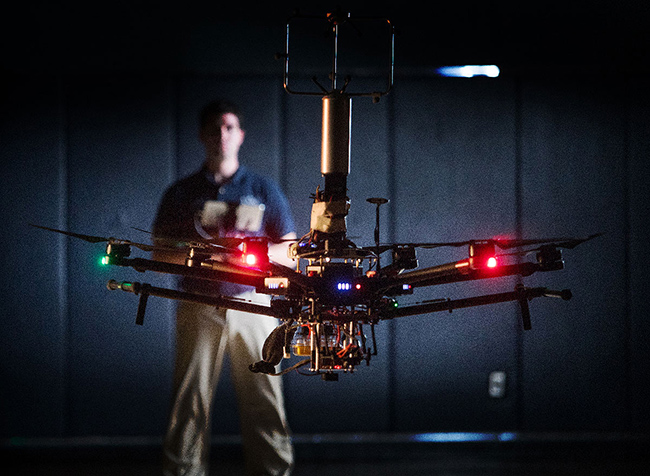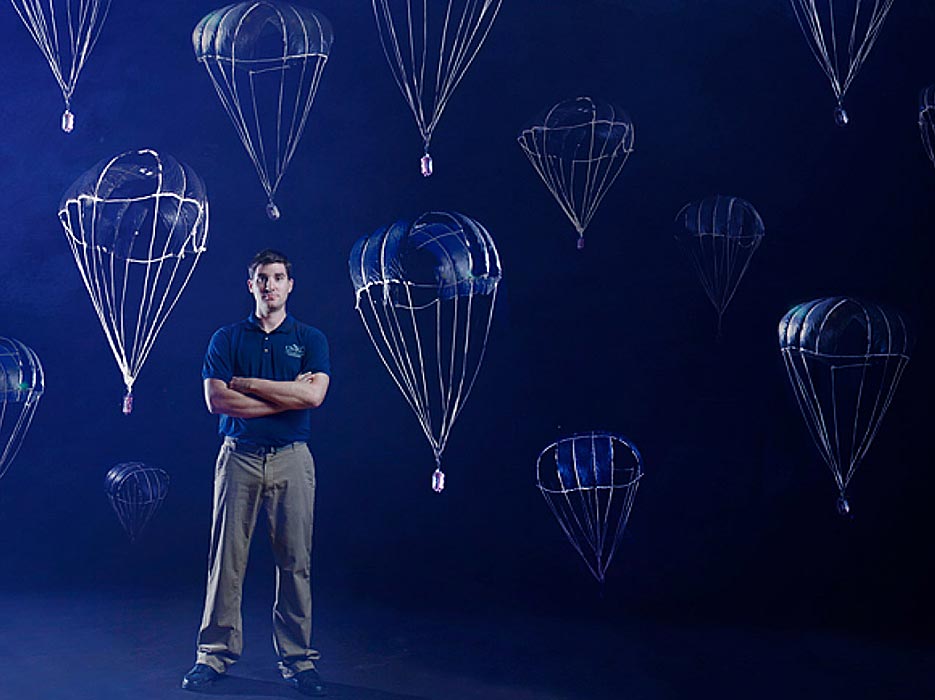When dropping supplies for military operations, every second and every detail matter — details like cost and accuracy. But it’s these details that have proven to be extremely difficult to overcome, especially when it comes to the precision of the drops. Even a gust of wind can have catastrophic results that directly affect the safety and security of troops stationed abroad.
This is an intense situation with serious consequences, and it’s one Travis Fields, Ph.D., assistant professor at the UMKC School of Computing and Engineering is surprised to find himself exploring often.
“During my graduate work, I definitely did not imagine all the ways the work I was doing could be translated and applied,” says Fields, whose research focuses on the applications of drone technology.
His work is certainly sought after and has garnered interest from several high-profile government agencies, including the U.S. Army Natick Soldier Research, Development and Engineering Center (NSRDEC) and NASA. Grant funding from these organizations has allowed Fields and his research partner from the Naval Postgraduate School, Oleg Yakimenko, Ph.D., to collaborate on innovative parachute technologies to accurately drop supplies from safer altitudes.
Dangerous Drops
The Department of Defense started out performing the drops from very low altitudes to ensure they do not miss the target. Over time, the team is working to scale up and drop from higher altitudes. Its next test, targeted for December 2019, will make a 30-foot drop.
“Unfortunately, this puts the aircrew in harm’s way, and there are many cases of aircraft filled with bullet holes,” Fields says.
An alternative is to use a parafoil system like the canopies used by skydivers. These systems have sophisticated control algorithms that enable high accuracy; however, they are expensive — often upward of $80,000 — and are usually reserved for the direst situations. Currently, there are no great low-cost, yet accurate, delivery options that can be employed from safe altitude
Nevertheless, the DOD still needs effective methods to safely get supplies to troops on the ground.
“As we have continued to push the limits and boundaries of our operational bases, aerial resupply has become the only way to provide goods,” Fields says.
Another complication that hinders successful supply drops is rugged terrains of hard-to-reach drop zones and unpredictable weather.
“Winds are the major factor that impact aerial delivery,” Fields says. “Winds change constantly, and if the predictions are off the true wind by even a few miles per hour, the payload can be off by hundreds to thousands of feet.”
In short, accuracy is crucial in these missions and can save lives. “Most — if not all — incidents have come from using unguided systems that missed the target,” Fields says. “By having gliding capability, we hope to hit the right location and avoid such issues.
Safer Landing
With cost and accuracy needs in mind, Fields, Yakimenko and SCE students are testing a cruciform, or cross canopy system, that is manufactured with two rectangular nylon panels that are sewn together. This process, according to the researchers, is significantly easier and less expensive than trying to create the complex shape of the parafoil.
“This system, which is probably an order of magnitude cheaper than those based on a parafoil, demonstrates a capability to rely on a calculated aerial release point and uses a limited control authority to steer toward a desired point of impact,” Yakimenko says.
The package is fitted with an airborne guidance unit that features sensors and Raspberry Pi, a credit-card-sized computer, to provide real-time situational awareness. Additionally, the Raspberry Pi controls a motor that pulls on a particular suspension line of the parachute and allows for more accurate gliding to reach the desired target.
As Fields and his team continue to test this novel system, they have been fortunate to have unique experiences and increasing grant support along the way.
Test Runs
Fields and his team recently had an opportunity to do testing from UH-60 Black Hawk helicopters at the Army Yuma Proving Ground.
“It was a great opportunity and enabled us to show that our system really is steering and could be a more cost-effective method for aerial delivery,” Fields says.
To date, Fields has secured $75,000 from NASA’s Established Program to Stimulate Competitive Research to further explore unmanned systems and models. NASA even provided the team with five days of fully supported testing in its vertical spin tunnel at the NASA Langley Research Center, the only one of its kind in the Western hemisphere. Additionally, the primary partner in the research, the U.S. Army NSRDEC, has provided $418,386 since its initial award in 2015.
“I definitely did not imagine all the ways the work I was doing could be translated and applied.”
The funding, Fields says, is essential to the research and has helped the team run experiments at Camp Roberts in California on several occasions. Camp Roberts is an Army National Guard base with a restricted airstrip, McMillan Airfield, used for unmanned aircraft. While there, the team uses both fixed-wing and large multirotor unmanned aircrafts to carry packages up to 4,000 feet and then deploy the systems. To gain additional insight into the parachute guidance performance, the team uses a quadcopter to chase after the parachutes to collect video footage of the descent. This helps diagnose what the system is doing and adjust for future tests. The team will conduct its December test at a skydiving in Eloy, Ariz.
“Going to places like Camp Roberts and Eloy is absolutely crucial for us to test our steering and guidance methodologies,” Fields says. “Out there we can go higher and farther away than in the national airspace around Kansas City, which currently limits operations to 400 feet without a waiver.”
Though the tests are only the beginning of developing and implementing this technology, Fields is happy to report positive results.
“We have performed two tests from 4,000 feet above ground where we were within 10 feet of the target, and a test from 6,000 feet where we were near 300 feet from the target,” Fields says. He adds that the success their work has seen is directly attributable to the support from the UMKC School of Computing and Engineering and the passion the students have. Yakimenko agrees.

“I enjoy working with the undergraduate and graduate students from UMKC because of their desire to be involved in real-world, defense-related applications, as well as their creativity, readiness, thoroughness and willingness to stay for several days in a desert, where we usually conduct our tests,” Yakimenko says. “I know I can always rely on Dr. Fields’ team.”
The team’s system has great potential to increase precision delivery capabilities for critical military missions, particularly when costs inhibit more complex parafoil-based deliveries. Fields’ system features descent profiles that are not currently achievable with other glide systems, which means his system can achieve more accurate drops, more successful missions and save more lives.
“This low-cost approach opens up the potential for semi-precision delivery in a variety of scenarios well beyond military use, including aid relief for situations like the hurricane in Puerto Rico or any other major disaster or crisis,” Fields says. “I believe this will be a transformational technique for aerial delivery operations in both military and humanitarian relief efforts in the years to come.”
This story originally appeared in Vanguard, the UMKC School of Computing and Engineering research magazine.

